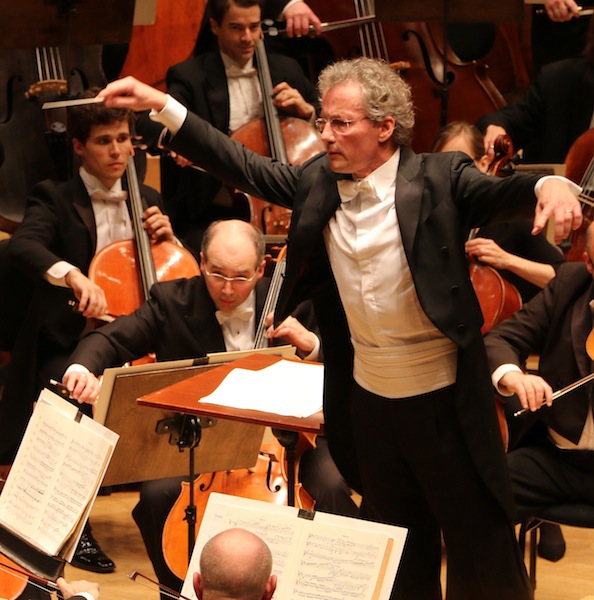Cleveland Orchestra shows its refined mettle in Beethoven, Sibelius

The last time the Cleveland Orchestra played in Chicago was 2002 when Franz Welser-Möst was in his first season as music director of the celebrated ensemble, which George Szell lifted to international standards, a reputation that continued under Lorin Maazel and Christoph von Dohnanyi.
Welser-Möst and the Clevelanders returned to Orchestra Hall Saturday night for a rather ungenerous (69 minutes) pairing of Beethoven and Sibelius symphonies. It’s unfortunate that an intriguing Bach-Bruckner program was rejected by Chicago Symphony artistic planners, but still the concert provided a timely look at the ensemble. After 15 seasons and forty new musicians hired by the current music director, one can truly say that it is now Welser-Möst’s orchestra.
As with the CSO, the Clevelanders had to contend with Orchestra Hall’s arid post-renovation acoustic. Having heard the Cleveland Orchestra regularly during the first years of their Miami residency, it seemed that the ensemble’s distinctive character was affected by the string-bleaching effect of the venue. The corporate sound seemed to be somewhat muted and dry, the strings missing some of their silvery refinement and transparency.
Even so, Beethoven’s Symphony No. 8 made a worthy calling card for Welser-Möst and the players, and demonstrated that the Cleveland Orchestra remains among the finest orchestras in the country with playing polished to a high sheen, airtight articulation, and seamless, nimble strings.
Welser-Möst led an alert, well played and responsive Beethoven Eighth overall but the performance felt rather cool and straitlaced in one of the composer’s most humor-laden symphonies. The metronomic tick-tock of the Allegretto was clearly presented yet literal and unsmiling–like the Cleveland musicians themselves–with Beethoven’s subversive spirit seeming to be veiled and lurking behind a curtain.
The two horns brought welcome rustic color to a rather bloodless menuetto and the performance overall would have benefited from more personality like that. The finale is one of Beethoven’s wittiest inspirations and while Welser-Möst took the music at a crackling pace, the overall effect was dogged and insistent rather than joyful and bumptious. Wind playing was restrained to the point of being a bit faceless, with an especially reticent bassoon.
All the Cleveland principals were on stage for Sibelius’s Symphony No. 2 after intermission, which seemed to make a world of difference–not just in a more luxuriant sonority from the full string and wind sections but in the greater character and individuality of the playing.
Welser-Möst takes a somewhat idiosyncratic view of the Finnish composer’s symphony, seeming to place it more firmly in the Russian tradition Sibelius was emerging from, rather than the more singular, austere style he was cultivating. Tempos were brisk and sonorities weighty, lacking something of the cool, elemental Northern atmosphere.
Yet the Austrian conductor showed a clear feel for the tricky ebb and flow of Sibelius’s music, especially in the Andante, benefiting from the burnished darkness of the cellos and basses and plangent and evocative solo work from oboist Frank Rosenwein and the other wind principals.
Apart from some jarring horn blats in the first movement, the Cleveland ensemble delivered impassioned, superbly committed playing across all sections. The initial appearance of the finale’s big theme was rushed through, reducing some of its impact, yet Welser-Möst built up the tension to the finale with consummate skill, and the theme’s majestic reemergence was duly triumphant even if the final chord sounded strangely tentative.
The resounding cheers and ovations brought Welser-Möst back out for four curtain calls. Considering the orchestra’s long history with Czech music, Smetana’s Overture to The Bartered Bride made a fitting encore. The delightful, bubbling winds and exhilarating sperformance sealed the evening in rousing style.
Posted in Performances





Posted Jan 25, 2017 at 3:04 pm by D.R.Reynolds
Thanks for your review. The disappointing sound of the hall was most evident. Is there any chance that this will be corrected? I found the last movement of the Beethoven more pleasing than you did. Most enjoyable in both the Beethoven and Sibelius was the clarity of structure, warmth of lower strings, and convincing use of soft passages especially in the final movement of the Sibelius which produced a less powerfully triumphant but more elegantly beautiful interpretation than I had heard before.
I will now explore the recordings of this conductor and his orchestra, and hope they will return next year. I will make a request for this in my next season’s subscription.
Posted Feb 02, 2017 at 7:38 am by MarkB
After the first movement of the Beethoven, I asked whether I was transported to a different hall. At least in the lower balcony, I had never heard the sound so good at Orchestra Hall before, which I credit to the orchestra and conductor. It was not as good as other halls, but much better than what we are used to hearing.
One could quibble with some soft balances in the Beethoven, but overall Welser-Most delivered a convincing performance. The Sibelius was perhaps more in the style of Colin Davis than George Szell, but ultimately very convincing and again Welser-Most had a strong grasp on the structure. He does have a tendency to pull back a bit a big moments. The soft playing was spellbinding. The Smetena encore was played with precision, style and abandon. Very memorable and phenomenal concert.